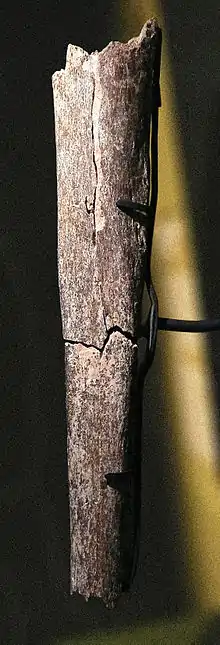Boxgrove Man
Boxgrove Man is a name given to three fossils thought to be of Homo heidelbergensis, an extinct relative of modern humans (Homo sapiens), found at Boxgrove in Sussex, and dated to roughly half a million years old. One piece of the tibia (shinbone) and two teeth were found. The tibia was of a mature well-built man, and the teeth are thought to be of the same mature adult. They are the oldest fossils of the genus homo found in Britain.

H. Heidelbergensis fossils
The site at Boxgrove in Sussex dates to the late Cromerian Stage, around 500,000 years ago, and it is the earliest site in Britain with fossils of the genus homo.[1] The tibia was discovered in 1993 by archaeologist Mark Roberts and his team of the Institute of Archeology at University College London.[2] The two teeth were found in 1995 and 1996 on returns to the site in the hope, which was realised, of finding further remains. The tibia was originally about 40 centimetres (1 ft 4 in) long and is of a well-built male with a height of 177–182 centimetres (5 ft 10 in – 6 ft 0 in). The teeth were lower incisors found about a metre apart and are thought to belong to the same individual, a mature adult.[3] The exceptional structural strength suggests a cold-adapted body with proportions paralleling those of the Neanderthals.[4] Archaeological evidence indicates that these early humans had the ability to hunt or at least scavenge with stone tools as the team discovered hundreds of Acheulean flint tools at the site.[5] The two teeth found show scratches, suggesting an eating technique in which food was cut with a tool whilst gripped between the jaws.[6]
The site
Boxgrove in this period evolved from coastal mudflats beneath chalk cliffs to a mosaic of habitats as the sea retreated. There were then areas of grassland, pools, scrub and woodland, with diverse prey and supplies of flint which made the area attrative to early humans. Prey included horse and probably deer.[7] Other mammal fossils were of extinct species of rhinoceros, bears, and voles.[8] It is most likely that H. heidelbergensis hunted these animals for sustenance with the aid of the stone tools also discovered at this site. There is clear evidence on the animal remains that they were butchered, but it cannot be proven that the species whose fossil was found in association with them hunted these animals or scavenged them. Teeth marks on the tibia fossil may be evidence that he or she was scavenged as well, either by cannibalism or scavenging by another animal.[9]
See also
References
- Ashton, Nick (2017). Early Humans. London, UK: William Collins. pp. 53, 63, 104. ISBN 978-0-00-815035-8.
- Roberts, M. B.; Stringer, C. B.; Parfitt, S. A. (1994). "A hominid tibia from Middle Pleistocene sediments at Boxgrove, UK". Nature. 369 (6478): 311–313. Bibcode:1994Natur.369..311R. doi:10.1038/369311a0. PMID 8183368. S2CID 29743115.
- Ashton, Early Humans, p. 104
- Stringer, C. B.; Trinkaus, E.; Roberts, M. B. (May 1998). "The Middle Pleistocene human tibia from Boxgrove". Journal of Human Evolution. 34 (5): 509–547. doi:10.1006/jhev.1998.0215. PMID 9614636.
- Stout, Dietrich; Apel, Jan; Commander, Julia; Roberts, Mark (2014-01-01). "Late Acheulean technology and cognition at Boxgrove, UK". Journal of Archaeological Science. 41: 576–590. doi:10.1016/j.jas.2013.10.001. ISSN 0305-4403.
- Neil Oliver (2012). A History of Ancient Britain. United Kingdom: W&N. p. 480. ISBN 978-0753828861.
- Ashton, Early Humans, p. 105
- "500000 BC - Boxgrove - Current Archaeology". Current Archaeology. 2007-05-24. Retrieved 2018-01-30.
- A History of Britain, Richard Dargie (2007), p. 8–9